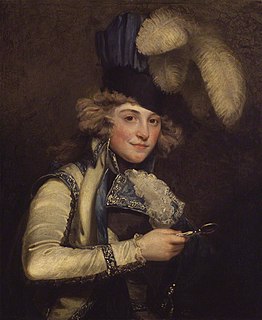Related Research Articles

Dorothea Jordan, also known interchangeably as Mrs Jordan and previously Miss Francis or Miss Bland, was an Anglo-Irish actress, courtesan and the mistress and companion of the future King William IV of the United Kingdom for 20 years (1791–1811) while he was Duke of Clarence. Together they had ten illegitimate children, all of whom took the surname FitzClarence.

George Stephen Kemble was a successful English theatre manager, actor, and writer, and a member of the famous Kemble family.

Theophilus Cibber was an English actor, playwright, author, and son of the actor-manager Colley Cibber.

The Theatre Royal, Drury Lane, commonly known as Drury Lane, is a West End theatre and Grade I listed building in Covent Garden, London, England. The building faces Catherine Street and backs onto Drury Lane. The building is the most recent in a line of four theatres which were built at the same location, the earliest of which dated back to 1663, making it the oldest theatre site in London still in use. According to the author Peter Thomson, for its first two centuries, Drury Lane could "reasonably have claimed to be London's leading theatre". For most of that time, it was one of a handful of patent theatres, granted monopoly rights to the production of "legitimate" drama in London.

Helena Saville Faucit, Lady Martin was an English actress.
Christopher Rich (1657–1714) was a lawyer and theatrical manager in London in the late 17th and early 18th century.

Charlotte Charke was an English actress, playwright, novelist, autobiographer, and noted transvestite. She acted on the stage from the age of 17, mainly in breeches roles, and took to wearing male clothing off the stage. She assumed the name "Charles Brown" and called her daughter "Mrs. Brown." She suffered a series of failures in her business affairs after working in a variety of trades commonly associated with men, from valet, to sausage maker, farmer, pastry chef, and tavern owner, but finally achieved success under her own name as a writer, ending her life as a novelist and memoirist.
The patent theatres were the theatres that were licensed to perform "spoken drama" after the Restoration of Charles II as King of England, Scotland and Ireland in 1660. Other theatres were prohibited from performing such "serious" drama, but were permitted to show comedy, pantomime or melodrama. Drama was also interspersed with singing or dancing, to prevent the whole being too serious or dramatic.

Lisle's Tennis Court was a building off Portugal Street in Lincoln's Inn Fields in London. Originally built as a real tennis court, it was used as a playhouse during two periods, 1661–1674 and 1695–1705. During the early period, the theatre was called Lincoln's Inn Fields Playhouse, also known as The Duke's Playhouse, The New Theatre or The Opera. The building was demolished and replaced by a purpose-built theatre for a third period, 1714–1728. The tennis court theatre was the first public playhouse in London to feature the moveable scenery that would become a standard feature of Restoration theatres.

Gustavus Vaughan Brooke, commonly referred to as G. V. Brooke, was an Irish stage actor who enjoyed success in Ireland, England and Australia.

The United Company was a London theatre company formed in 1682 with the merger of the King's Company and the Duke's Company.

George John Bennett (1800–1879) was for nearly 40 years a Shakespearian actor on the London stage, notably Covent Garden and Drury Lane.
Thomas Elrington (1688–1732), was an English actor.

David Fisher (II) (1788–1858) was an English actor, and one of the managers of Fisher's company, which had a monopoly of the Suffolk theatres.
The Warwickshire Company of Comedians, also known as Mr Ward's Company of Comedians and after 1767 as Mr Kemble's Company of Comedians, was a theatre company established by John Ward in Birmingham, England in the 1740s, touring throughout the West Midlands region and surrounding counties over subsequent decades. Unusual in the 18th century as a provincial company producing performances to London tastes and standards, it is particularly notable as the origin of the Kemble family theatrical dynasty, which was to dominate the English stage in the late-18th and early 19th centuries. Sarah Siddons and John Philip Kemble in particular, who were Ward's grandchildren and whose careers began in the company, were the leading actress and actor of their time, and are still considered among the greatest performers in English theatrical history.
Benjamin Griffin (1680–1740), was an English actor and dramatist. He was the son of the Rev. Benjamin Griffin, rector of Buxton and Oxnead in Norfolk, and chaplain to the Earl of Yarmouth.
Harriet Elizabeth Savill née Diddear, later married name Farren, known as Mrs Faucit) (1789–1857) was an English actress.

Thomas Manders was an actor-manager and low comedian of the early 19th century.
Walter Lacy was an English actor. In a long career he played leading roles in London theatres.

Strafford is an 1837 tragedy by the British writer Robert Browning. It portrays the downfall and execution of Lord Strafford, the advisor to Charles I shortly before the English Civil War.
References
- ↑ Forde, Lauren (23 July 2019). "Our History - Theatre Royal". theatreroyal.org. Retrieved 1 October 2021.
- Elizabeth Grice, Rogues and Vagabonds, or the Actors' Road to Respectability; Terence Dalton Limited, Lavenham, Suffolk, 1997, ISBN 0-900963-78-6